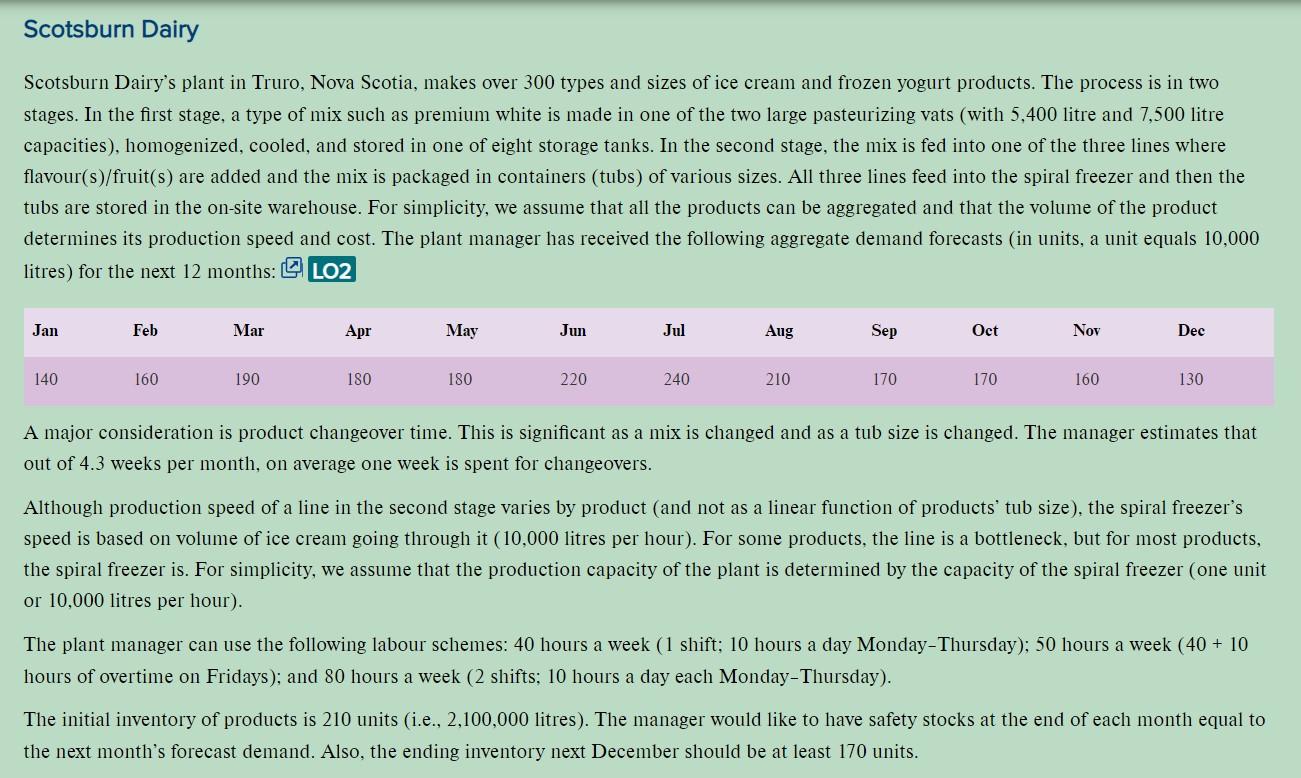Home /
Expert Answers /
Operations Management /
scotsburn-dairy-scotsburn-dairy-39-s-plant-in-truro-nova-scotia-makes-over-300-types-and-sizes-of-i-pa900
(Solved): Scotsburn Dairy Scotsburn Dairy's plant in Truro, Nova Scotia, makes over 300 types and sizes of i ...
Scotsburn Dairy Scotsburn Dairy's plant in Truro, Nova Scotia, makes over 300 types and sizes of ice cream and frozen yogurt products. The process is in two stages. In the first stage, a type of mix such as premium white is made in one of the two large pasteurizing vats (with 5,400 litre and 7,500 litre capacities), homogenized, cooled, and stored in one of eight storage tanks. In the second stage, the mix is fed into one of the three lines where flavour(s)/fruit(s) are added and the mix is packaged in containers (tubs) of various sizes. All three lines feed into the spiral freezer and then the tubs are stored in the on-site warehouse. For simplicity, we assume that all the products can be aggregated and that the volume of the product determines its production speed and cost. The plant manager has received the following aggregate demand forecasts (in units, a unit equals 10,000 litres) for the next 12 months:LO2 Jan Feb Mar Apr May Jun Jul Aug Sep Oct Nov Dec 140 160 190 180 180 220 240 210 170 170 160 130 A major consideration is product changeover time. This is significant as a mix is changed and as a tub size is changed. The manager estimates that out of 4.3 weeks per month, on average one week is spent for changeovers. Although production speed of a line in the second stage varies by product (and not as a linear function of products' tub size), the spiral freezer's speed is based on volume of ice cream going through it (10,000 litres per hour). For some products, the line is a bottleneck, but for most products, the spiral freezer is. For simplicity, we assume that the production capacity of the plant is determined by the capacity of the spiral freezer (one unit or 10,000 litres per hour). The plant manager can use the following labour schemes: 40 hours a week (1 shift; 10 hours a day Monday-Thursday); 50 hours a week (40 + 10 hours of overtime on Fridays); and 80 hours a week (2 shifts; 10 hours a day each Monday-Thursday). The initial inventory of products is 210 units (i.e., 2,100,000 litres). The manager would like to have safety stocks at the end of each month equal to the next month's forecast demand. Also, the ending inventory next December should be at least 170 units.
Scotsburn has on-site warehouse space for 6,500 pallets of products. Each pallet's load differs by tub size. For example, 550 two-litre tubs can be placed on a pallet. For simplicity, we will use this as a measure of on-site warehouse capacity (i.e., 6500 (550)(2) = 7,150,000 litres or 715 units). The production cost of the 40-hour-a-week labour scheme (requiring three freezer operators, nine freezer packers, one freezer bypass, five palletizers, one quality control lab supervisor, one lab technician, two wash-up staff, four mixers, one production supervisor, one maintenance manager, and four maintenance workers) is $78,408 per month. Overtime production cost is 1.5 times regular time production. A temp worker's production cost is the same as a permanent worker's. The average hiring cost of 32 temp workers required to run the plant is $500 each, charged to the first month of employment. Value of one litre of product is $1, cost of capital is 11 percent per year, each pallet holds 1,100 litres, and warehousing cost is $20 per pallet per month. From these, inventory holding cost per unit (10,000 litres) per month is 0.11 ($1)(10,000)/12 +20(10,000/1100) = $273. Shortage/back order is highly undesirable. Assume a cost of $1,000 per unit per month back ordered. Question What is the minimum cost aggregate production plan for Scotsburn Dairy? (Hint: Use the second shift in May and June, supplemented by overtime in several months.)
Expert Answer
Hi..bro..iam effected with Corona from last few days... I don't have much time to do these all.. B

